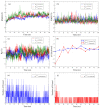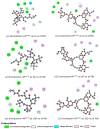In Silico Comparative Analysis of Ivermectin and Nirmatrelvir Inhibitors Interacting with the SARS-CoV-2 Main Protease
- PMID: 39062468
- PMCID: PMC11274663
- DOI: 10.3390/biom14070755
In Silico Comparative Analysis of Ivermectin and Nirmatrelvir Inhibitors Interacting with the SARS-CoV-2 Main Protease
Abstract
Exploring therapeutic options is crucial in the ongoing COVID-19 pandemic caused by SARS-CoV-2. Nirmatrelvir, which is a potent inhibitor that targets the SARS-CoV-2 Mpro, shows promise as an antiviral treatment. Additionally, Ivermectin, which is a broad-spectrum antiparasitic drug, has demonstrated effectiveness against the virus in laboratory settings. However, its clinical implications are still debated. Using computational methods, such as molecular docking and 100 ns molecular dynamics simulations, we investigated how Nirmatrelvir and Ivermectin interacted with SARS-CoV-2 Mpro(A). Calculations using density functional theory were instrumental in elucidating the behavior of isolated molecules, primarily by analyzing the frontier molecular orbitals. Our analysis revealed distinct binding patterns: Nirmatrelvir formed strong interactions with amino acids, like MET49, MET165, HIS41, HIS163, HIS164, PHE140, CYS145, GLU166, and ASN142, showing stable binding, with a root-mean-square deviation (RMSD) of around 2.0 Å. On the other hand, Ivermectin interacted with THR237, THR239, LEU271, LEU272, and LEU287, displaying an RMSD of 1.87 Å, indicating enduring interactions. Both ligands stabilized Mpro(A), with Ivermectin showing stability and persistent interactions despite forming fewer hydrogen bonds. These findings offer detailed insights into how Nirmatrelvir and Ivermectin bind to the SARS-CoV-2 main protease, providing valuable information for potential therapeutic strategies against COVID-19.
Keywords: Ivermectin; Nirmatrelvir; SARS-CoV-2; main protease (Mpro); molecular docking; molecular dynamics.
Conflict of interest statement
The authors declare no conflicts of interest.
Figures





Similar articles
-
Molecular Insights into Structural Dynamics and Binding Interactions of Selected Inhibitors Targeting SARS-CoV-2 Main Protease.Int J Mol Sci. 2024 Dec 16;25(24):13482. doi: 10.3390/ijms252413482. Int J Mol Sci. 2024. PMID: 39769245 Free PMC article.
-
Exploring epigenetic drugs as potential inhibitors of SARS-CoV-2 main protease: a docking and MD simulation study.J Biomol Struct Dyn. 2024 Aug;42(13):6892-6903. doi: 10.1080/07391102.2023.2236714. Epub 2023 Jul 17. J Biomol Struct Dyn. 2024. PMID: 37458994
-
AI-driven covalent drug design strategies targeting main protease (mpro) against SARS-CoV-2: structural insights and molecular mechanisms.J Biomol Struct Dyn. 2025 Jul;43(11):5436-5464. doi: 10.1080/07391102.2024.2308769. Epub 2024 Jan 29. J Biomol Struct Dyn. 2025. PMID: 38287509 Review.
-
Insight into crystal structures and identification of potential styrylthieno[2,3-b]pyridine-2-carboxamidederivatives against COVID-19 Mpro through structure-guided modeling and simulation approach.J Biomol Struct Dyn. 2024 May;42(8):4325-4343. doi: 10.1080/07391102.2023.2220799. Epub 2023 Jun 15. J Biomol Struct Dyn. 2024. PMID: 37318002
-
Recent Advances in SARS-CoV-2 Main Protease Inhibitors: From Nirmatrelvir to Future Perspectives.Biomolecules. 2023 Sep 2;13(9):1339. doi: 10.3390/biom13091339. Biomolecules. 2023. PMID: 37759739 Free PMC article. Review.
Cited by
-
Molecular Insights into Structural Dynamics and Binding Interactions of Selected Inhibitors Targeting SARS-CoV-2 Main Protease.Int J Mol Sci. 2024 Dec 16;25(24):13482. doi: 10.3390/ijms252413482. Int J Mol Sci. 2024. PMID: 39769245 Free PMC article.
References
-
- Louten J. Essential Human Virology. Academic Press; Cambridge, MA, USA: 2016. Virus transmission and epidemiology; pp. 71–92. - DOI
-
- Asadi S. Airborne Infectious Disease Transmission via Expiratory Aerosol Particles and Aerosolized Fomites. University of California; Davis, CA, USA: 2020.
Publication types
MeSH terms
Substances
Grants and funding
LinkOut - more resources
Full Text Sources
Miscellaneous

